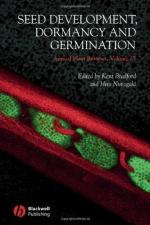|
This section contains 1,075 words (approx. 4 pages at 300 words per page) |

|
A seed is an enclosed, protected package of cells surrounding a miniature plant, the embryo, that can grow to form a copy of the plant bearing it. Seeds thus serve to spread and propagate plants, but they can also help the plant survive unfavorable climatic conditions, such as a freezing winter, in the form of the protected embryo.
A typical seed consists of three main parts. The outer layer, or seed coat, protects the interior contents against drying out, infection, attack by predators, and noxious chemicals in the environment; it may also bear hooks or other structures that attach the seed to passing animals, aiding dissemination. The innermost structure is the embryo, complete with root tip, stem tip, and specialized seed leaves called cotyledons. Between these two structures lies the endosperm, cells containing stored food that the embryo digests and uses as an energy...
|
This section contains 1,075 words (approx. 4 pages at 300 words per page) |

|


